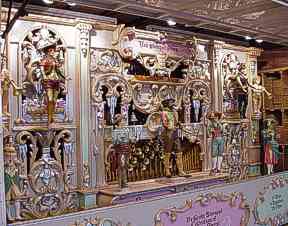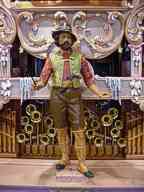Steenput Freres 97-Key Concert Fair Organ
 According to Art Reblitz, the author of The Golden Age of Automatic Musical Instruments, only the largest, most powerful fairground organs qualify for the name of concert fairground organ. The Steenput Fr�res organ featured on this audio CD, known at the De Grote Steenput, meets this requirement, and it is a superbly colorful example of a large concert fairground organ. It was built in 1928 by Steenput Fr�res, a small company that was located in Puurs, Belgium. The Steenput brothers designed their organs to incorporate pipework combinations and voices from both the French and German fairground organ traditions, blending them into a delicious musical mix that is at once unique and traditional in musical tone.
According to Art Reblitz, the author of The Golden Age of Automatic Musical Instruments, only the largest, most powerful fairground organs qualify for the name of concert fairground organ. The Steenput Fr�res organ featured on this audio CD, known at the De Grote Steenput, meets this requirement, and it is a superbly colorful example of a large concert fairground organ. It was built in 1928 by Steenput Fr�res, a small company that was located in Puurs, Belgium. The Steenput brothers designed their organs to incorporate pipework combinations and voices from both the French and German fairground organ traditions, blending them into a delicious musical mix that is at once unique and traditional in musical tone.
Taking from the French, this magnificent instrument contains many temperamentally diverse and throaty ranks of reed pipes, while from the German tradition it makes use of numerous violin, flute, high-pitched mixture and contrabass ranks of pipes. And, since it was impossible to fit all the 786 pipes into the standard large sized cabinet, a second, but much smaller cabinet was made to sit in front of the main casework. The brass trumpet pipes visible at the center of the instrument, behind the center figure, is the most obvious pipe rank located in the secondary cabinet. Although the Steenput name is perhaps not as well recognized as that of some other much more famous fair organ builders, Steenput organs are, nonetheless, admirably crafted instruments and they are equally as musical and able to play concert arrangements as are organs made by any of the major and better known manufacturers.
 Adding to the visual beauty of the instrument are the carved wooden figures, which in this case are animated and an elegant addition to the large and elaborate decorative facade. The 44-inch tall animated figure in the center is a likeness of Andreas Hofer, a Tyrolese patriot, who keeps time with the baton in his right hand, indicates soft and loud passages with his left hand, and periodically turns his head. The two statues flanking the center figure are two of the four animated bell ringers.
Adding to the visual beauty of the instrument are the carved wooden figures, which in this case are animated and an elegant addition to the large and elaborate decorative facade. The 44-inch tall animated figure in the center is a likeness of Andreas Hofer, a Tyrolese patriot, who keeps time with the baton in his right hand, indicates soft and loud passages with his left hand, and periodically turns his head. The two statues flanking the center figure are two of the four animated bell ringers.
Reportedly, the organ was originally used by the Vermolen Amusement Company as an attraction and to provide musical pleasure in conjunction with a "dodgem" car ride. Thereafter, a succession of one or two interim owners saved the Steenput organ from destruction, before it was purchased by James Krughoff, who in 1993 shipped the aging instrument to John Verbeeck (St.-Job-in-`t-Goor, Belgium) for restoration. Now beautifully restored, both mechanically and visually, the huge De Grote Steenput organ can once again be enjoyed.
It plays 97-key van Steenput folding music books by arrangers such as Schollaert and Carl Frei, with brand new and modern arrangements by Tom Meijer and Wayne Holton. Instrumentation includes 786 pipes, controlled by 15 automatic registers, with voices representing violin, flute, piccolo, high-pitched mixtures, trumpet and trombone, along with bells (melody division), bass drum, tympani effect, snare drum, cymbal, triangle and tambourine.
The selection of music on this CD ranges from popular melodies to impressive renditions of classical favorites. The quality of the digital recording used as source material was very good, so that only minor signal processing using professional grade software was deemed prudent. This was done in order to remove a hint of motor hum, so as to enhance the overall listening experience.
Credits:
Photos: James Krughoff
Further Reading:
The Golden Age of Automatic Musical Instruments, by Art Reblitz, pages 232-233.
Steenput Freres Concert Fair Organ
11 Tracks -- Total Time: 70:56 |
|---|
| 1. | Buglers Holiday |
| 2. | Bones Trombone |
| 3. | Pine Top Boogie |
| 4. | Gaite Parisianne |
| 5. | Barnum and Bailey's Favorite |
| 6. | Tales of the Vienna Woods |
| 7. | Lohengrin: Prelude to Act 3 |
| 8. | Invictus |
| 9. | Ride of the Valkyries |
| 10. | Tannhauser |
| 11. | Star Wars |
Listen to a sample.....
 "BUGLER'S HOLIDAY"
"BUGLER'S HOLIDAY"
Back to Compact
Discs page
Back
to website homepage
 According to Art Reblitz, the author of The Golden Age of Automatic Musical Instruments, only the largest, most powerful fairground organs qualify for the name of concert fairground organ. The Steenput Fr�res organ featured on this audio CD, known at the De Grote Steenput, meets this requirement, and it is a superbly colorful example of a large concert fairground organ. It was built in 1928 by Steenput Fr�res, a small company that was located in Puurs, Belgium. The Steenput brothers designed their organs to incorporate pipework combinations and voices from both the French and German fairground organ traditions, blending them into a delicious musical mix that is at once unique and traditional in musical tone.
According to Art Reblitz, the author of The Golden Age of Automatic Musical Instruments, only the largest, most powerful fairground organs qualify for the name of concert fairground organ. The Steenput Fr�res organ featured on this audio CD, known at the De Grote Steenput, meets this requirement, and it is a superbly colorful example of a large concert fairground organ. It was built in 1928 by Steenput Fr�res, a small company that was located in Puurs, Belgium. The Steenput brothers designed their organs to incorporate pipework combinations and voices from both the French and German fairground organ traditions, blending them into a delicious musical mix that is at once unique and traditional in musical tone. Adding to the visual beauty of the instrument are the carved wooden figures, which in this case are animated and an elegant addition to the large and elaborate decorative facade. The 44-inch tall animated figure in the center is a likeness of Andreas Hofer, a Tyrolese patriot, who keeps time with the baton in his right hand, indicates soft and loud passages with his left hand, and periodically turns his head. The two statues flanking the center figure are two of the four animated bell ringers.
Adding to the visual beauty of the instrument are the carved wooden figures, which in this case are animated and an elegant addition to the large and elaborate decorative facade. The 44-inch tall animated figure in the center is a likeness of Andreas Hofer, a Tyrolese patriot, who keeps time with the baton in his right hand, indicates soft and loud passages with his left hand, and periodically turns his head. The two statues flanking the center figure are two of the four animated bell ringers.